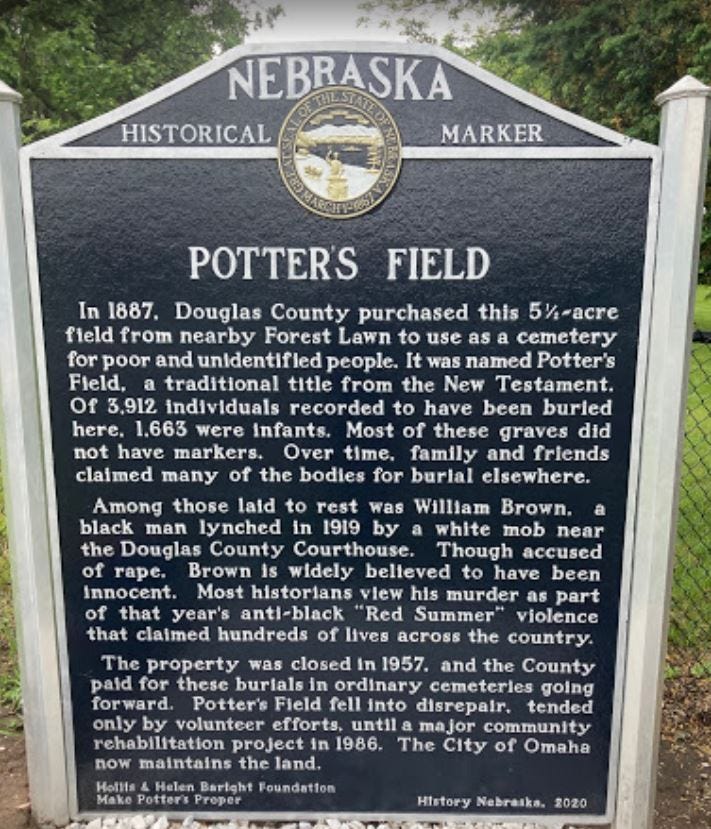Update: The Ku Klux Klan did not attempt to organize in Nebraska until the 1920s. It was largely anti-Catholic at the time. Republican Governor Samuel Roy McKelvie opposed and spoke out against the Ku Klux Klan. (https://unlhistory.unl.edu/xslt/xslt.php?&_xmlsrc=https://unlhistory.unl.edu/legacy/unl.00026/unl.00026.03.xml&_xslsrc=https://unlhistory.unl.edu/xslt/unlhistory.xsl and https://livinghistoryfarm.org/farminginthe30s/life_32.html and https://en.wikipedia.org/wiki/Samuel_Roy_McKelvie )
Equal Justice Initiative has installed plaques at the Douglas County Courthouse in Omaha regarding past lynchings. One of the plaques, “Lynching in America”, ignores much of Nebraska's history and is inaccurate. Nebraska historian James Potter researched the topic and found Nebraska had at least 57 lynchings and the vast majority of them were white people (https://nebraskapublicmedia.org/en/news/news-articles/nebraska-lynch-mobs-not-always-a-wild-west-creation-says-historian/). This plaque would make sense in Alabama, or places where the Ku Klux Klan operated, but not in Nebraska. I do not understand how it was permitted to be placed on government property.
Also, Nebraska, which became a state after the Civil War, was largely settled by Republicans and former Union soldiers such as John Thayer (https://en.wikipedia.org/wiki/John_Milton_Thayer), and Captain John O’Neill ( https://en.wikipedia.org/wiki/John_O%27Neill_(Fenian) and https://history.nebraska.gov/publications_section/oneill-gen-john/) and others. Thayer would become a US Senator and argue in favor of the 14th Amendment of the Constitution. He would later become governor of Nebraska. O’Neill would be Captain over the 17th US Colored Infantry composed of Black men (https://en.wikipedia.org/wiki/17th_United_States_Colored_Infantry_Regimentand). O'Neill is buried in Omaha at Holy Sepulcher cemetery.
In addition to the 13th, 14th, and 15th Amendments, a Republican Congress also passed the Anti-Ku Klux Klan Act of 1871. Also, in 1869, Omaha Republicans would not allow the state capital in Omaha to be moved, unless the capital was named after President Lincoln but this history is seldom recognized. Black men would join the US military and be known as Buffalo soldiers and some were stationed at Fort Robinson, Nebraska (https://mynehistory.com/items/show/137). Because of Republicans and Union veterans, many Blacks deemed it safe to come to Omaha and Nebraska.
The plaque contains another error in talking about the “ideology of white supremacy”. Hate and violence do not make an ideology. This plaque is out of step with the historical facts and mischaracterizes what took place. The historical marker at Potter’s Field recognizes the lynching of William Brown and considers his death as part of the Red Summer of 1919 (https://www.history.com/topics/black-history/chicago-race-riot-of-1919).
The attack on Black people had been the result of the Great Migration of Black people from the south to the north from 1916 to 1918 due to the War. The end of the War brought people into economic conflict and the result was race riots and murders where Blacks were most often the victims.
As for Nebraska and Omaha histories, many are not just plain ignorant, but often very dismissive of this Republican heritage which not only opposed slavery, violence, and racism but advocated for the advancement of equality before the law.






The Ku Klux Klan was the militant arm of the Democratic Party. Lynchings certainly were conducted on black people who dared pursue or defend their freedom, but in general, lynchings were conducted on opponents of the Democratic Party and its goals. This included white men — many of them in Omaha as Andrew points out. Why does this plaque omit the vast majority of Omaha lynchings if not to foster racial hate?
FWIW, yes, the Klan was active in the southeastern part of Nebraska up until around the mid-20th century. They weren't, however, universally supported or encouraged.
My grandfather had things to say about this back when he was still alive. He was deeply opposed to their activities.